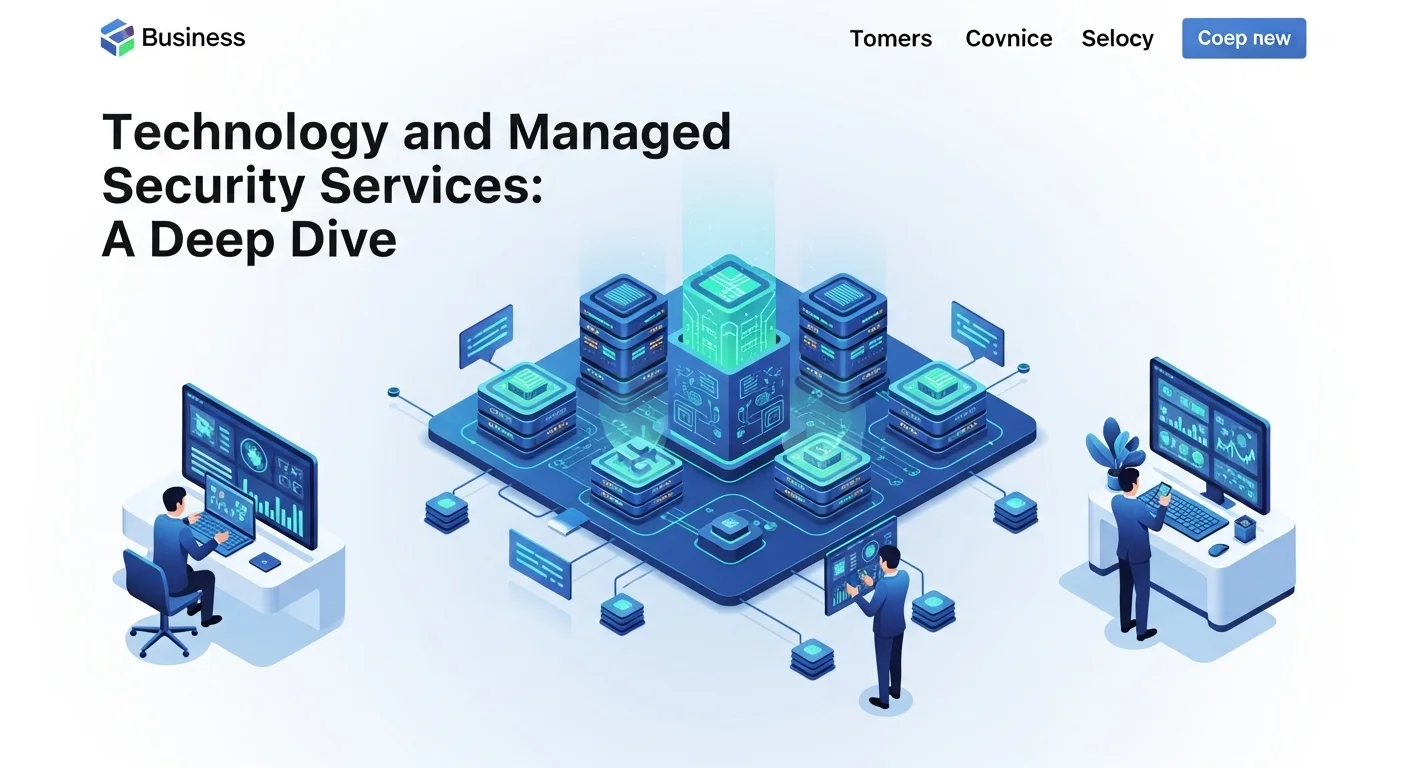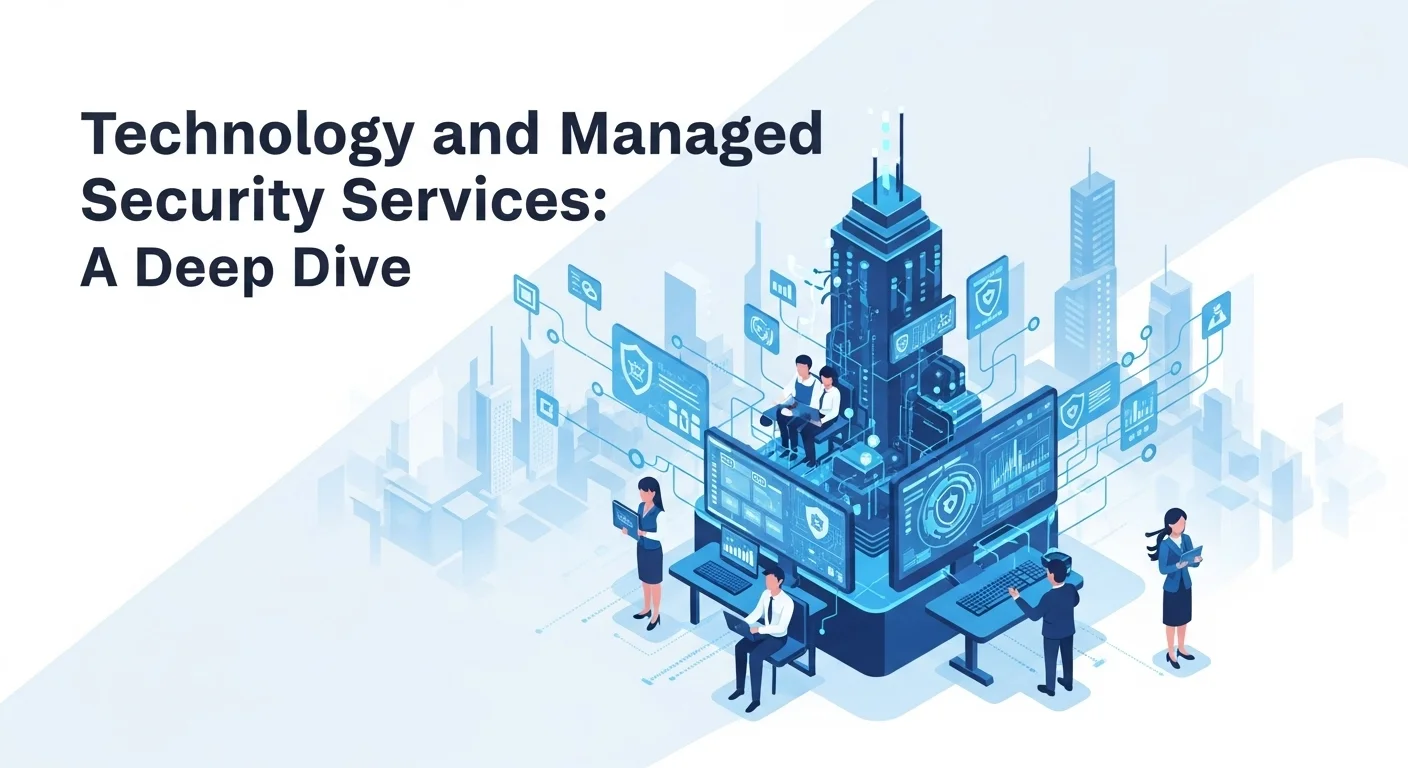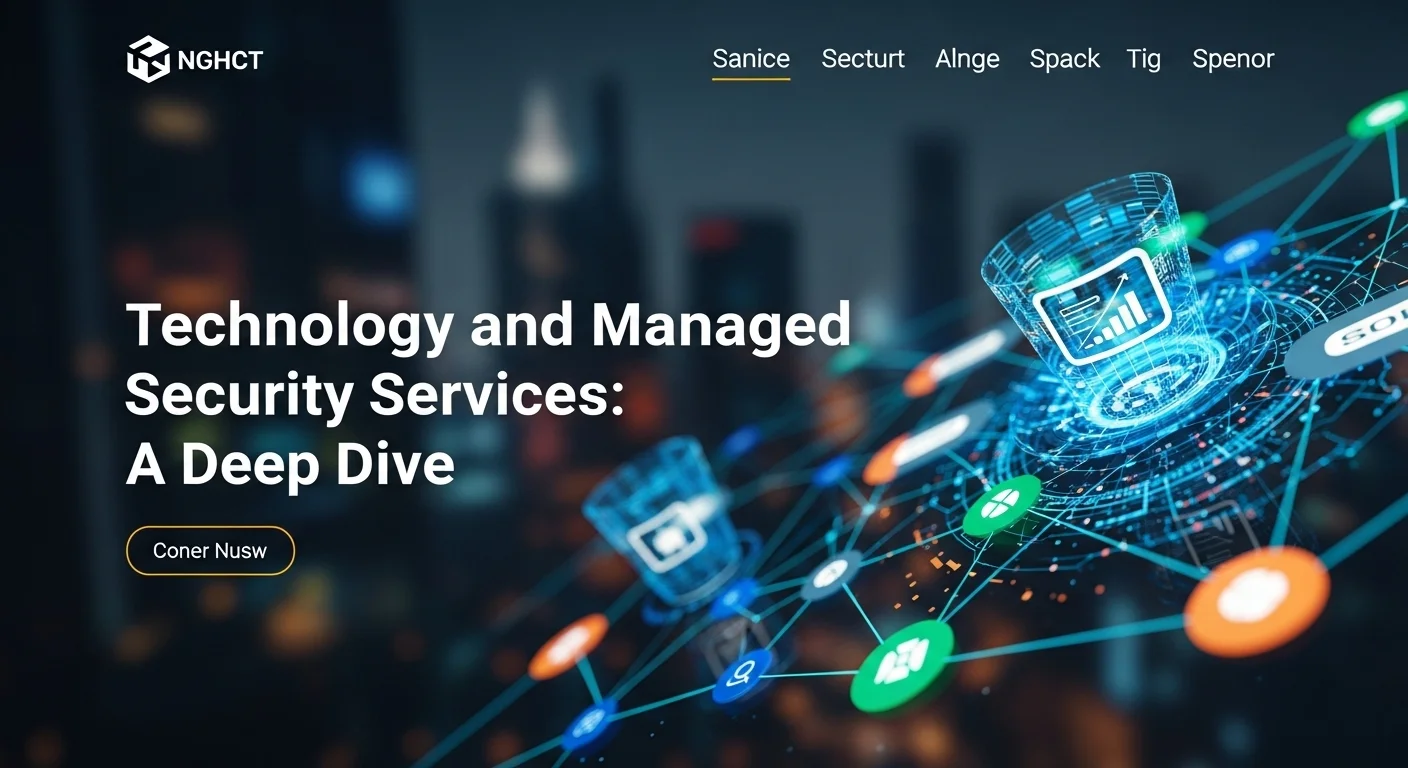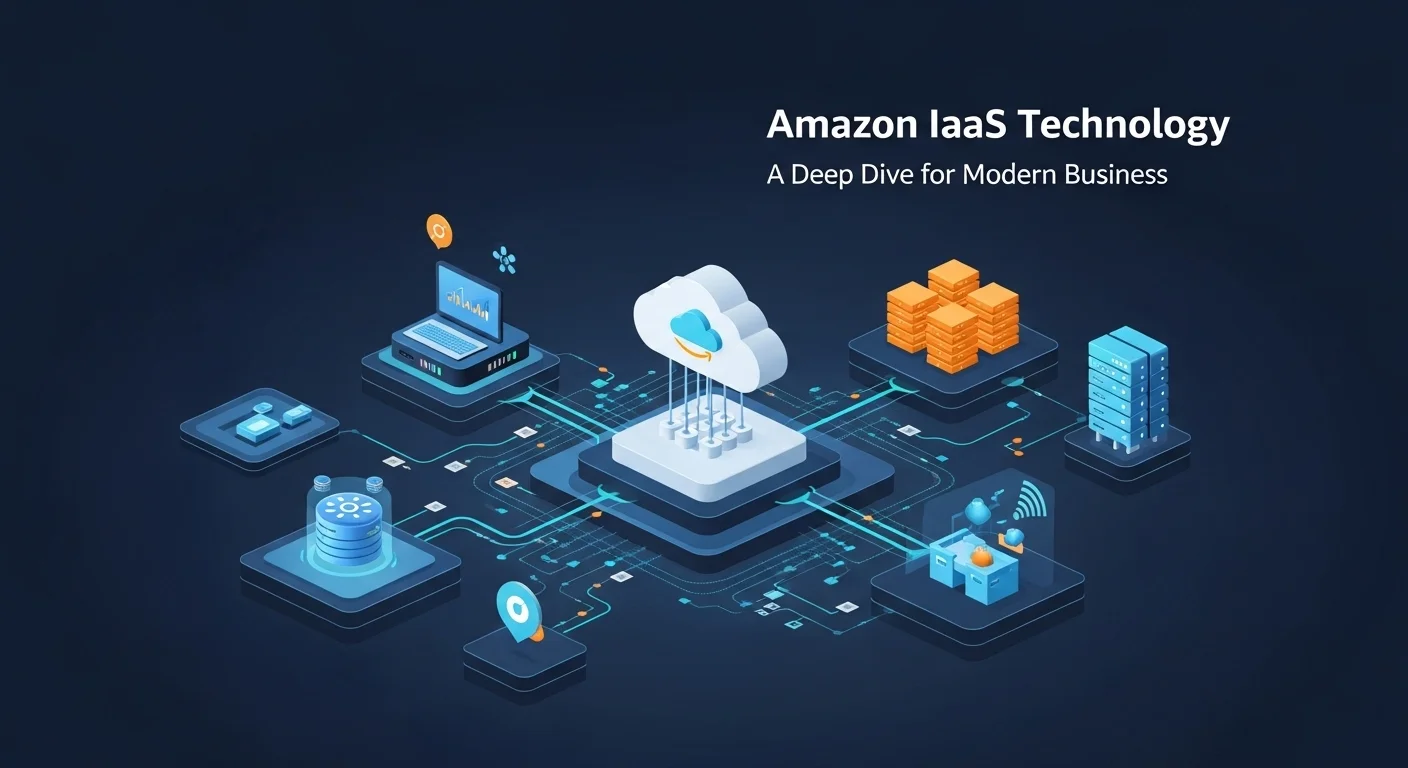Are You Truly Secure? A Plain-English Guide to Managed Security Services

Executive Summary
In today's world, it feels like the digital walls are constantly closing in. The threat of a cyberattack is something that keeps business owners up at night. I've been in this field for a long time, and I've seen that anxiety firsthand. That's where Managed Security Services (MSS) come in. Think of it as hiring a team of elite digital bodyguards for your business. This article is my attempt to cut through the jargon and explain what these services are and why they've become absolutely essential. We'll explore the real-world benefits, like having experts on your side 24/7 and actually saving money in the long run. I'll even give you my take on the big players like IBM and AT&T. For anyone in tech or leading a business, this guide will show you how to turn security from a nagging expense into your greatest strength, giving you the peace of mind to focus on what you do best: growing your business.
Table of Contents
- What Are Managed Security Services, Really? And Why They Matter More Than Ever
- The Core Components of a Strong Security Service
- Real-World Business Applications and Tangible Benefits
What Are Managed Security Services, Really? And Why They Matter More Than Ever
In my years in cybersecurity, I've watched the landscape shift from a simple cat-and-mouse game to a full-blown digital warzone. Every business, no matter how small, is a target. The threats are getting smarter and faster, from ransomware that can paralyze your operations to data breaches that can shatter customer trust. In the middle of all this chaos, a powerful strategy has become the bedrock of modern defense: Managed Security Services (MSS). In simple terms, MSS means you're outsourcing your digital security to a company that lives and breathes this stuff—a Managed Security Service Provider (MSSP). They handle the day-to-day grind of security, from watching your network around the clock to jumping into action the second something looks wrong. This isn't just about handing off tasks; it's about forming a strategic partnership to fortify your defenses with expertise and technology you likely couldn't afford on your own.
The importance of this in today's tech world can't be overstated. Think about your company's IT setup. You probably have servers here, cloud services there, and employees connecting from everywhere. That digital footprint is a huge, open invitation for attackers. Securing it all is a massive job, and frankly, most in-house IT teams are already stretched thin. There’s a massive global shortage of cybersecurity talent, which makes hiring your own team of experts incredibly difficult and expensive. This is where MSSPs shine. They bring a team of seasoned pros and an arsenal of high-tech tools to the table. By partnering with an MSSP, you gain access to a dedicated Security Operations Center (SOC) that's on guard 24/7/365. I've seen it time and again: this 'always on' coverage is the difference between catching a threat early and reading about your company in the headlines for the wrong reasons.
The Core Components of a Strong Security Service
To truly get why MSS is such a game-changer, you need to know what you're actually getting. While services can be customized, they usually revolve around a few key pillars that build a strong, proactive defense.
- 24/7 Monitoring and Management: This is the foundation. It means someone is always watching your networks, servers, and devices for any sign of trouble. Using powerful systems called SIEMs (Security Information and Event Management), they sift through mountains of data to spot threats that a human would miss.
- Threat Detection and Incident Response: When a threat is found, you need to act fast. MSSPs have a plan. They investigate the breach, contain it so it can't spread, get rid of the attacker, and help you get back to normal. A good response plan minimizes damage and downtime.
- Vulnerability Management and Penetration Testing: A proactive strategy means finding and fixing your weaknesses before hackers do. MSSPs regularly scan your systems for vulnerabilities and even simulate attacks (penetration testing) to see where you're exposed. They then give you a clear, actionable plan to patch those holes.
- Firewall and Intrusion Prevention Management: Your network's border is your first line of defense. MSSPs manage your firewalls and other security gates, making sure they're properly configured, updated, and blocking malicious traffic.
- Compliance Management: Depending on your industry, you might have to follow strict data protection rules like GDPR, HIPAA, or PCI DSS. Navigating these can be a nightmare. MSSPs have experts who can implement the right security controls and provide the reports you need to prove you're compliant, saving you from massive fines and headaches.
Deciding to manage security services through a partner is a major strategic decision. It allows a business, especially a small or medium-sized one (SMB), to access enterprise-level security without the enterprise-level price tag. Cybercriminals love targeting SMBs because they often have weaker defenses. Outsourcing levels that playing field. Industry leaders like IBM Managed Security Services and AT&T Managed Security Services have built powerful solutions that can scale with any business, offering much more than just basic monitoring to protect you from the most sophisticated attacks.
Real-World Business Applications and Tangible Benefits
The impact of managed IT security services is felt across every industry. In finance, they protect sensitive customer data. In healthcare, they guard patient records. In retail, they secure online stores and payment systems. The goal is always the same: reduce risk, protect what's valuable, and keep the business running smoothly. The benefits are clear and make a real difference to the bottom line.
First and foremost is cost-effectiveness. I've seen companies try to build their own security operations center, and the cost is staggering. The technology, the office space, and especially the salaries for a team of experts can run into the millions. MSSPs offer a predictable monthly fee, turning a huge capital expense into a manageable operating cost. This frees up your money and your people to focus on what they do best.
Another huge benefit is access to top-tier expertise and technology. MSSPs employ teams of security veterans who have seen it all. They also invest millions in the latest security tools, like AI-powered threat detection and automated response systems. This means you get the best protection available without having to buy and manage it yourself.
Finally, the scalability and flexibility are invaluable. As your business grows, your security needs will change. An MSSP can easily adjust its services to match your growth, whether you're moving to the cloud or expanding internationally. But perhaps the most important benefit I hear from clients is peace of mind. Knowing that a team of experts has your back 24/7 lets you and your leadership team sleep at night. You can focus on innovation and growth, confident that your digital foundation is secure. This makes the decision to use managed security services not just a tech choice, but a smart business move that builds resilience for the future.

Complete Guide to Managed Security Services in Technology and Business
Navigating the cybersecurity world can feel like trying to drink from a firehose. For many businesses I've worked with, Managed Security Services (MSS) have been the answer to taming that chaos. This guide is my attempt to pull back the curtain on the technology, business strategies, and resources that make these services work. To truly get the most out of an MSSP, you have to know how to manage security services as a strategic asset, not just another line item on the budget. The ultimate goal is to shift from being reactive—always putting out fires—to being truly resilient, where you can anticipate threats and your defenses are always one step ahead.
The engine behind a great MSSP is a sophisticated, interconnected system of technology. It’s not just a pile of software; it’s a finely tuned architecture built for one purpose: to see, analyze, and respond to threats. The heart of this system is almost always a Security Information and Event Management (SIEM) platform. A SIEM is a data vacuum, pulling in log information from every corner of your IT environment—firewalls, servers, cloud accounts, you name it. By looking at all this data together, it can spot suspicious patterns that would be invisible otherwise. The problem? A SIEM can be noisy. That's where Security Orchestration, Automation, and Response (SOAR) comes in. SOAR acts as a filter and a first responder, automating routine tasks like blocking a malicious IP address. This frees up the human experts to focus on the truly complex threats that require creativity and intuition to solve.
The Technology Stack: Powering Modern Defense
Beyond SIEM and SOAR, an MSSP's tech stack has several other key layers. Endpoint Detection and Response (EDR) and its bigger sibling, Extended Detection and Response (XDR), are crucial for protecting the laptops and phones your team uses every day. EDR watches for suspicious activity on these devices, catching things like ransomware that old-school antivirus might miss. XDR takes it a step further, connecting the dots between your endpoints, network, and cloud services to give a full picture of an attack.
Threat intelligence is another non-negotiable component. MSSPs are plugged into global networks that share information about the latest attack methods, malware, and hacker groups. I’ve seen how this works up close; it’s like getting a daily briefing on the enemy's battle plans. A provider like IBM Managed Security Services, for example, leans heavily on its world-famous X-Force research team. This constant stream of intelligence allows them to protect clients from threats before they even become widespread.
Finally, vulnerability management tools continuously scan your systems for weak spots, like unpatched software or misconfigurations. The MSSP doesn't just find these problems; they tell you which ones are most critical to fix first, helping you systematically shrink your attack surface. This multi-layered stack is what allows a top-tier MSSP to deliver truly effective managed IT security services.
Business Techniques for Successful MSSP Integration
From a business perspective, just signing the check isn't enough. I always tell my clients that this is a partnership. It needs clear communication, defined roles, and a collaborative spirit. The first step is to look in the mirror and do a thorough assessment of your own needs. What are your crown jewels? What keeps you up at night? What regulations do you have to follow? Knowing the answers helps you pick the right provider and set clear expectations.
A detailed Service Level Agreement (SLA) is your best friend. This document should spell out everything: what services they'll provide, how fast they'll respond to an incident, who to call, and what reports you'll get. It’s critical to define who does what. For instance, if the MSSP finds a vulnerability, who is responsible for actually applying the patch? Getting these details right from the start prevents a world of confusion later.
Communication is everything. You should have regular meetings and access to a clear dashboard that shows you what’s happening. This transparency builds trust and helps you understand the value you're getting. Many of the most successful partnerships I've seen use a co-managed model, where the MSSP acts as an extension of your internal team. This blends their 24/7 expertise with your team's intimate knowledge of the business—it's a powerful combination.
Comparing the Titans: IBM vs. AT&T Managed Security Services
When you're looking at the top of the market, IBM Managed Security Services and AT&T Managed Security Services are two names that always come up. They're both giants, but they have different philosophies.
IBM Managed Security Services is all about deep intelligence and analytics. They leverage their powerful QRadar SIEM platform and the brainpower of their X-Force IRIS team to offer incredibly advanced threat detection. In my experience, they excel with large, complex organizations that need a unified view of their security across a mix of on-premise and cloud environments. They are the go-to for a data-driven, intelligence-led security program.
AT&T Managed Security Services, on the other hand, comes at security from the network up. Leveraging the massive amount of traffic that flows through their global network gives them unique visibility into threats. Their approach is built around their Threat Intellect platform, which uses machine learning to spot malicious activity across their infrastructure. Recently, they've been focused on embedding security directly into their connectivity services, which is a compelling offer for businesses, especially small and medium-sized ones, looking for an all-in-one solution from a single provider. They are a fantastic choice for companies that see security and networking as two sides of the same coin.
The right choice depends entirely on you. If your world is all about complex data and analytics, IBM might be a better fit. If you're looking for tightly integrated security and connectivity, AT&T could be the answer. The key is to do your homework and choose a partner that aligns with your specific risks, technology, and business goals.

Tips and Strategies to Maximize Your Managed Security Services
Getting the most out of your partnership with a Managed Security Service Provider (MSSP) is an ongoing process. I've seen many companies sign a contract and then sit back, thinking the job is done. But the real value comes when you actively integrate the MSSP into your organization's DNA. By doing this, you can elevate your Managed Security Services from a simple cost of doing business to a strategic advantage that fosters innovation. Here are some of my best tips and strategies for getting there, focusing on best practices and how to leverage providers like IBM Managed Security Services and AT&T Managed Security Services to the fullest.
The single most important strategy is to treat your MSSP like a partner, not a vendor. This sounds simple, but it's a profound shift in mindset. It means building a relationship based on open communication and shared goals. Remember, you can outsource security tasks, but you can never outsource your own risk. It’s still your company on the line. I always recommend setting up regular strategic reviews with your MSSP—not just to look at dashboards, but to talk about the big picture. Discuss the changing threat landscape, your upcoming business plans (like a new product launch), and how your security strategy needs to evolve with them. This proactive dialogue is what keeps your security from becoming a roadblock to progress.
Best Practices for a Thriving MSSP Partnership
To really manage security services effectively and build a strong partnership, here are a few best practices I've seen work time and again:
- Establish Crystal-Clear Communication and Escalation Paths: When a crisis hits, you can't be fumbling around trying to figure out who to call. Work with your MSSP to document exactly who to contact and what to expect for different types of incidents. This should be a core part of your Service Level Agreement (SLA). Clarity here saves precious time and prevents chaos during an emergency.
- Build a Human Firewall Internally: Your technology is only as strong as your weakest human link. Many breaches start with a simple phishing email. Use the intelligence from your MSSP—the kinds of threats they're seeing target you—to create specific security awareness training for your employees. When your team knows what to look for and how to report it, they become an active part of your defense.
- Integrate, Don't Isolate: The insights your MSSP provides are pure gold, so don't let them sit in a silo. A vulnerability report should flow directly into your IT team's to-do list for patching. Threat intelligence should be used to assess the risk of new business projects. Weaving these security insights into your daily operations creates a much more robust and holistic approach to managing risk.
- Practice, Practice, Practice: Don't wait for a real attack to test your defenses. I strongly advise my clients to work with their MSSP to run regular drills, like tabletop exercises. These simulations test your joint incident response plan, find the weak spots in your process, and build muscle memory for both your team and the MSSP's. It's the best way to prepare for the real thing.
Leveraging Business Tools and Tech Experiences
To get the best experience from your managed IT security services, you need to master the tools they give you. Your MSSP's client portal or dashboard is your main window into their world. Get to know it. These dashboards give you real-time visibility into security events and your overall security health. Using this tool effectively allows you to see the value they're delivering and hold them accountable.
Think about how to connect your MSSP's tech with your own internal processes. If you have a software development team, for example, work with your MSSP to embed security checks directly into the development pipeline (a practice known as DevSecOps). This helps you find and fix security flaws early on, when it's much cheaper and easier to do so.
Top-tier providers like IBM Managed Security Services offer access to powerful platforms like QRadar as part of their service. By leveraging these advanced tools, you can gain deep insights without the headache of managing the complex infrastructure yourself. Similarly, AT&T Managed Security Services often bundles its security offerings with its networking products, creating a seamless and simplified experience. Exploring these integrated solutions can make your life easier and your security stronger.
If you're looking for a great external resource to help frame your security conversations, I always point people to the National Institute of Standards and Technology (NIST) Cybersecurity Framework website. It provides a common language and a structured approach that you can use to work with your MSSP to improve your security posture over time.
In the end, the journey with an MSSP is a continuous collaboration. By adopting a strategic mindset, following best practices, and using the full suite of tools and expertise your provider offers, you can build a powerful partnership. This alignment is what will allow you to navigate the digital world safely and confidently, turning great security into your competitive edge.
Expert Reviews & Testimonials
Sarah Johnson, Business Owner ⭐⭐⭐⭐⭐
As a small business owner, the threat of cyberattacks is terrifying. This article broke down Managed Security Services in a way I could finally understand. The cost-effectiveness part really hit home. I feel much more prepared to have a conversation with a provider now.
Mike Chen, IT Consultant ⭐⭐⭐⭐
Solid overview. I'm an IT consultant, and I appreciated the clear comparison between IBM and AT&T. It's not just about features, but their core philosophy, which is a nuance often missed. I'll be sharing this with some of my clients.
Emma Davis, Tech Expert ⭐⭐⭐⭐⭐
Fantastic and thorough guide! As a security specialist, I found the section on integrating MSSP insights into the broader business operations particularly valuable. It’s a point I’m constantly making. Well-written and spot on.



